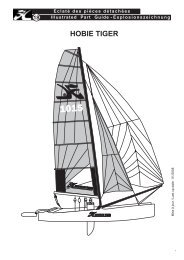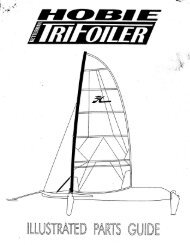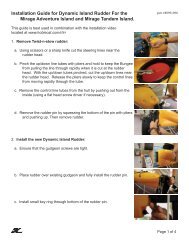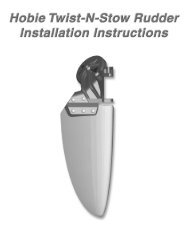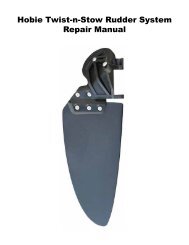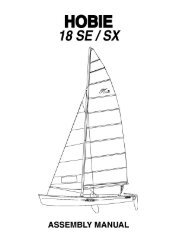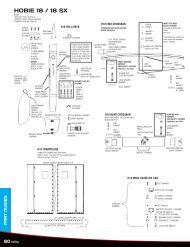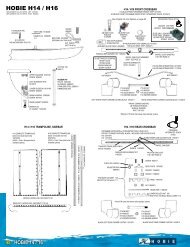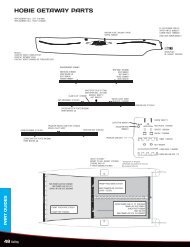ASSEMBLY MANUAL - Hobie Cat
ASSEMBLY MANUAL - Hobie Cat
ASSEMBLY MANUAL - Hobie Cat
Create successful ePaper yourself
Turn your PDF publications into a flip-book with our unique Google optimized e-Paper software.
SAILING YOUR GETAWAY<br />
Safe and sane guideline for the beginner; and an easy review<br />
for the experienced.<br />
Always wear a life jacket when boating.<br />
BALANCING THE BOAT<br />
When sailing, sit on the upwind side of the boat (wind on your<br />
back) just in front of the tiller, facing the sail. Balance your<br />
weight further outboard as the boat begins to tip or heel over<br />
with the wind in the sails. Tuck one foot under the hiking strap<br />
for balance. Use your hand that is forward to hold and control<br />
the mainsheet. Use your hand that is aft to steer.<br />
STEERING<br />
Steer the boat by pushing the tiller away from you to turn<br />
towards the wind. Pull the tiller towards you to turn away from<br />
the wind. Keep the movement of the tiller to a minimum to<br />
prevent over-steering. This will help you keep the boat moving<br />
in a straight line as you pay attention to other watercraft and<br />
sail adjustments.<br />
SAIL POWER<br />
Face the sail in order to pay close attention to the trim or<br />
adjustment of the sail. When the front of the sail, just behind<br />
the mast, luffs or flutters in the breeze, you lose power. To<br />
start moving, pull the sail in just enough to stop the sail from<br />
luffing. There are also short ribbons hanging on either side of<br />
the sail. Follow the diagram of sail and course adjustments<br />
above using the "tell tails" to get the most performance out of<br />
the sail for all angles of sailing. The tell tails react to air flowing<br />
over the sail and will help you see that the sail is pulled in too<br />
tight or too loosely. If you pull the sail too tight you will stall<br />
the sail power. Ease the sail out until it luffs, then pull it in just<br />
a little until it stops luffing. You will adjust the trim whenever<br />
the wind changes direction or you change course.<br />
CAN'T SAIL IN<br />
Close Hauled<br />
Close Reach<br />
Medium Reach<br />
Broad Reach<br />
WIND<br />
Downwind Run<br />
THIS AREA<br />
Close Hauled<br />
Close Reach<br />
Medium Reach<br />
Broad Reach<br />
14<br />
Refer to the sail trim diagram below for approximate sail<br />
settings for the different points of sail or directions you will be<br />
sailing. Note the "can't sail zone". You cannot sail in this<br />
direction due to the fact that the sail will luff constantly when<br />
pointed into the wind. If you get stuck in irons (or stop pointed<br />
into the wind) you will need to reverse the rudder and push the<br />
sail forward to back-wind it. The jib should be back winded by<br />
the crew to assist. This will back the boat up. Reverse the<br />
rudders and let the sail out until the boat is positioned more<br />
across the wind (close reach). Then you can correctly trim the<br />
sail and start moving forward.<br />
FALLING<br />
OFF<br />
HEADING UP<br />
WIND<br />
COMING<br />
ABOUT



